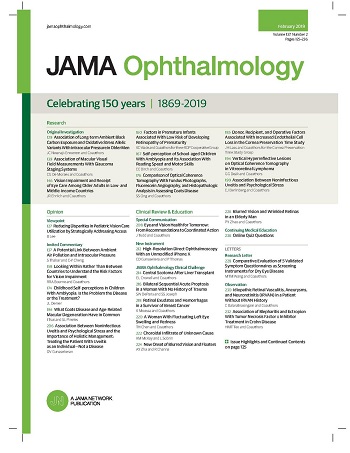A Competition for the Diagnosis of Myopic Maculopathy by Artificial Intelligence Algorithms.
IF 7.8
1区 医学
Q1 OPHTHALMOLOGY
引用次数: 0
Abstract
Importance Myopic maculopathy (MM) is a major cause of vision impairment globally. Artificial intelligence (AI) and deep learning (DL) algorithms for detecting MM from fundus images could potentially improve diagnosis and assist screening in a variety of health care settings. Objectives To evaluate DL algorithms for MM classification and segmentation and compare their performance with that of ophthalmologists. Design, Setting, and Participants The Myopic Maculopathy Analysis Challenge (MMAC) was an international competition to develop automated solutions for 3 tasks: (1) MM classification, (2) segmentation of MM plus lesions, and (3) spherical equivalent (SE) prediction. Participants were provided 3 subdatasets containing 2306, 294, and 2003 fundus images, respectively, with which to build algorithms. A group of 5 ophthalmologists evaluated the same test sets for tasks 1 and 2 to ascertain performance. Results from model ensembles, which combined outcomes from multiple algorithms submitted by MMAC participants, were compared with each individual submitted algorithm. This study was conducted from March 1, 2023, to March 30, 2024, and data were analyzed from January 15, 2024, to March 30, 2024. Exposure DL algorithms submitted as part of the MMAC competition or ophthalmologist interpretation. Main Outcomes and Measures MM classification was evaluated by quadratic-weighted κ (QWK), F1 score, sensitivity, and specificity. MM plus lesions segmentation was evaluated by dice similarity coefficient (DSC), and SE prediction was evaluated by R2 and mean absolute error (MAE). Results The 3 tasks were completed by 7, 4, and 4 teams, respectively. MM classification algorithms achieved a QWK range of 0.866 to 0.901, an F1 score range of 0.675 to 0.781, a sensitivity range of 0.667 to 0.778, and a specificity range of 0.931 to 0.945. MM plus lesions segmentation algorithms achieved a DSC range of 0.664 to 0.687 for lacquer cracks (LC), 0.579 to 0.673 for choroidal neovascularization, and 0.768 to 0.841 for Fuchs spot (FS). SE prediction algorithms achieved an R2 range of 0.791 to 0.874 and an MAE range of 0.708 to 0.943. Model ensemble results achieved the best performance compared to each submitted algorithms, and the model ensemble outperformed ophthalmologists at MM classification in sensitivity (0.801; 95% CI, 0.764-0.840 vs 0.727; 95% CI, 0.684-0.768; P = .006) and specificity (0.946; 95% CI, 0.939-0.954 vs 0.933; 95% CI, 0.925-0.941; P = .009), LC segmentation (DSC, 0.698; 95% CI, 0.649-0.745 vs DSC, 0.570; 95% CI, 0.515-0.625; P < .001), and FS segmentation (DSC, 0.863; 95% CI, 0.831-0.888 vs DSC, 0.790; 95% CI, 0.742-0.830; P < .001). Conclusions and Relevance In this diagnostic study, 15 AI models for MM classification and segmentation on a public dataset made available for the MMAC competition were validated and evaluated, with some models achieving better diagnostic performance than ophthalmologists.人工智能算法诊断近视性黄斑病变竞赛。
重要性变性黄斑病变(MM)是全球视力损伤的主要原因。从眼底图像中检测 MM 的人工智能(AI)和深度学习(DL)算法有可能改善诊断并帮助各种医疗机构进行筛查。目的评估用于 MM 分类和分割的 DL 算法,并将其性能与眼科医生的性能进行比较。参赛者获得了 3 个子数据集,分别包含 2306、294 和 2003 张眼底图像,并以此为基础建立算法。由 5 位眼科医生组成的小组对任务 1 和任务 2 的相同测试集进行了评估,以确定性能。模型集合(将 MMAC 参与者提交的多个算法的结果合并在一起)的结果与每个单独提交的算法进行了比较。本研究于 2023 年 3 月 1 日至 2024 年 3 月 30 日进行,数据分析于 2024 年 1 月 15 日至 2024 年 3 月 30 日进行。主要结果和测量MM分类通过二次加权κ(QWK)、F1 分数、灵敏度和特异性进行评估。通过骰子相似系数(DSC)评估 MM 加病变分割,通过 R2 和平均绝对误差(MAE)评估 SE 预测。MM 分类算法的 QWK 值范围为 0.866 至 0.901,F1 分数范围为 0.675 至 0.781,灵敏度范围为 0.667 至 0.778,特异性范围为 0.931 至 0.945。MM 加病变分割算法对漆裂(LC)的 DSC 值为 0.664 至 0.687,对脉络膜新生血管的 DSC 值为 0.579 至 0.673,对福克斯斑(FS)的 DSC 值为 0.768 至 0.841。SE 预测算法的 R2 范围为 0.791 至 0.874,MAE 范围为 0.708 至 0.943。与提交的每种算法相比,模型集合结果的性能最佳,模型集合在 MM 分类的灵敏度方面优于眼科医生(0.801; 95% CI, 0.764-0.840 vs 0.727; 95% CI, 0.684-0.768; P = .006)和特异性(0.946; 95% CI, 0.939-0.954 vs 0.933; 95% CI, 0.925-0.941; P = .009)、LC分割(DSC, 0.698; 95% CI, 0.649-0.745 vs DSC, 0.结论和相关性在这项诊断研究中,对为 MMAC 竞赛提供的公共数据集上用于 MM 分类和分割的 15 个人工智能模型进行了验证和评估,其中一些模型的诊断性能优于眼科医生。
本文章由计算机程序翻译,如有差异,请以英文原文为准。
求助全文
约1分钟内获得全文
求助全文
来源期刊

JAMA ophthalmology
OPHTHALMOLOGY-
CiteScore
13.20
自引率
3.70%
发文量
340
期刊介绍:
JAMA Ophthalmology, with a rich history of continuous publication since 1869, stands as a distinguished international, peer-reviewed journal dedicated to ophthalmology and visual science. In 2019, the journal proudly commemorated 150 years of uninterrupted service to the field. As a member of the esteemed JAMA Network, a consortium renowned for its peer-reviewed general medical and specialty publications, JAMA Ophthalmology upholds the highest standards of excellence in disseminating cutting-edge research and insights. Join us in celebrating our legacy and advancing the frontiers of ophthalmology and visual science.
 求助内容:
求助内容: 应助结果提醒方式:
应助结果提醒方式:


